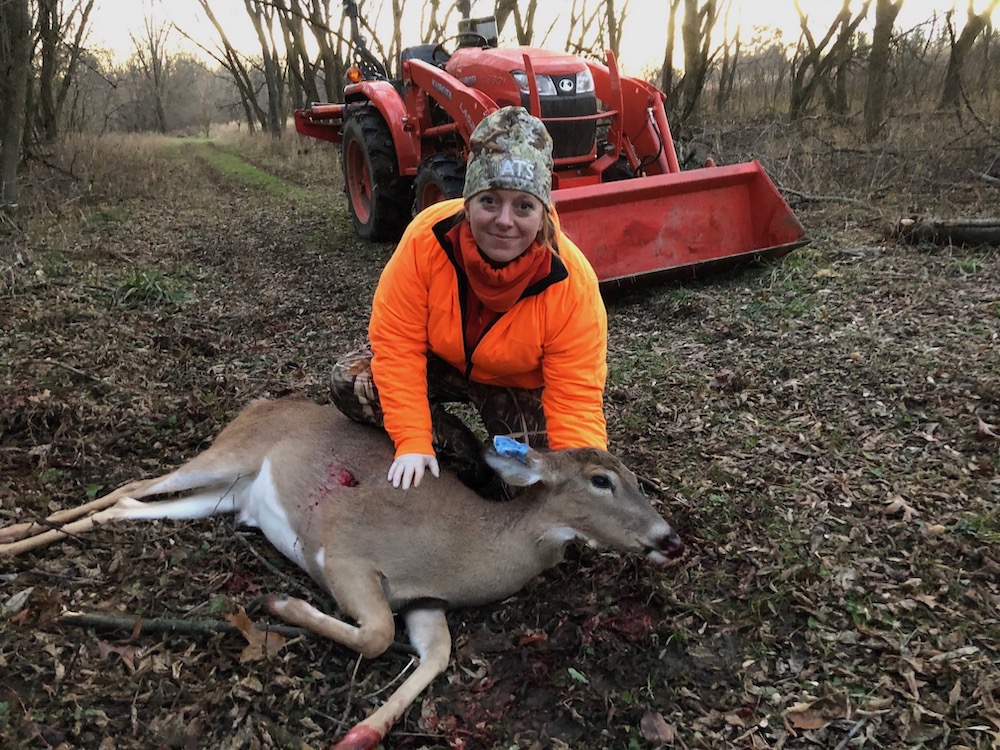
With the firearm deer hunting season kicking off this past Wednesday, many Michigan hunters have their minds set to bring home a winning whitetail. But for Sonja Christensen, an assistant professor in the Department of Fisheries and Wildlife in Michigan State University’s College of Agriculture and Natural Resources, the focus — now and all year long — is on protecting deer from disease.
Christensen’s research focuses on why diseases occur and how those diseases influence wildlife populations. One example is chronic wasting disease, or CWD, a fatal condition that is now affecting cervid populations, including deer, elk and moose throughout Michigan and other states. Christensen answers questions on what you should know about CWD and what research she is leading to prevent its spread.
What is CWD and how does it work?
Chronic wasting disease is a neurodegenerative condition caused by prions — an abnormal form of protein. It is not known to affect humans, but CWD is fatal in all cases involving cervids, or mammals that have solid deciduous antlers.
Transmission is thought to be caused by direct or indirect contact with infectious prions in bodily fluids like urine, feces or saliva. Studies show that prions can persist in the environment for years, meaning current exposure risks in a given area may stem from the presence of infected deer from long ago. Symptoms of CWD can take months or years to emerge and may include rapid weight loss, disorientation and fatigue, among others.
How many deer have died as a result of contracting CWD, and should we be concerned about a dwindling deer population?
Measuring how many wild deer are infected with a disease is a tremendous challenge. In fact, we do not have an exact number of how many free-ranging deer live in Michigan! Through surveillance work with the Michigan Department of Natural Resources, we know that CWD has been detected in 251 white-tailed deer since 2015. While that might not seem like a lot, it takes enormous effort to find sick deer, and there are likely more positive deer on the landscape that go undetected.
Research has shown that in cervid populations with a high prevalence of CWD, long-term population declines can occur. While deer are overabundant in many places in southern Michigan, they are a valuable native wildlife species, and we want to ensure they are healthy. White-tailed deer play a huge role in our ecosystems, culture and Michigan economy. Further, deer hunting license sales and excise taxes from firearms and ammunition generate funding that go directly to wildlife management and conservation for many more of our native species.
Should hunters be concerned about deer with CWD?
While CWD has never been conclusively detected in a human, my rule of thumb is that if it looks sick and you are concerned, do not eat it. Past research indicates some barrier exists between transmission of CWD from deer to humans, but more research is needed on this front. I recommend checking out the Michigan DNR’s current guidelines on testing for the best available options. Also, if you see a deer that appears sick, please report it to the MDNR. Finding a newly infected deer can be like finding a needle in a haystack, and we need all the eyes and ears we can get!
Where has CWD been detected, and is it a problem in Michigan?
CWD was first discovered in 1967 in Colorado and, according to the U.S. Geological Survey, it has been found in at least 31 states and four Canadian provinces. CWD also has been detected in a small number of European countries and in imported deer in South Korea.
The first CWD case in Michigan was discovered in 2008 in a captive whitetail and next in 2015 in a free-ranging deer. Since then, the disease has emerged in both the lower and upper peninsulas, but according to the MDNR, no new counties saw positive cases in 2022 sampling.

What findings have you made regarding the disease?
In an MDNR- and U.S. Fish and Wildlife Service-funded study published in the Journal of Wildlife Management in August 2022, my colleague and I found one of the complicating factors in managing CWD is the complex nature of white-tailed deer ecology. The persistence of prions in the environment, long-range deer movement and interactions with humans, such as the transportation of CWD-positive carcasses, are all unpredictable factors that our team’s models were designed to account for.
Further, I collaborate closely with colleagues from Cornell University on a project called SOP4CWD, which focuses on CWD surveillance and risk across states, to better understand how disease risks may differ in various regions of the United States. These efforts are all focused on finding the disease early so that state wildlife agencies have a chance at stopping its spread.
The Wildlife Society held a meeting in November where I presented research that a colleague and I conducted evaluating how other diseases — such as epizootic hemorrhagic disease, or EHD — interact with CWD to affect deer. We found that localized EHD outbreaks may actually help reduce CWD and provide a small silver lining in places where CWD has very recently emerged.
Much of my current work focuses on understanding and changing human behavior to help reduce risk factors for CWD in deer and to assist with disease management efforts. This might be in the form of finding incentives for helping hunters reduce the spread of disease from harvested deer or through cooperating with landowners to tackle disease management on private lands.
How can CWD be mitigated?
Our best chance to stop or slow disease spread is to prevent activities that we know are risky for CWD transmission, identify instances of disease early and give management agencies the upper hand in making proactive recommendations rather than reacting to disease outbreaks.
For a project partially funded by the MDNR published in the Wildlife Society Bulletin in March 2023, my colleague and I, as well as researchers from Mississippi State University, characterized management agencies’ CWD efforts in the U.S., Canada and Europe. Researchers reported the effects of management at various stages before and after detection.
Twelve of the 24 responding agencies had a weighted surveillance program in place, which puts a greater emphasis on deer with heightened risk factors. Initial responses to CWD detection included bans on movement of live or dead animals and increased bag limits.
We found that of the roughly 20 U.S. states and six Canadian provinces that have not found CWD, only three had active weighted surveillance programs in place. Just four of these states and two provinces had a response plan available online. Therefore, we recommended agencies be proactive in response plan development and to communicate with the public and other stakeholders on disease progression and management outcomes. Prevention is priceless.
What other disease-based research do you conduct?
My research program is aimed at understanding how and why diseases occur, and how that affects wildlife populations. As I mentioned, deer diseases of interest to me include epizootic hemorrhagic disease — a viral illness transmitted by biting midges — and blue tongue disease, a similar ailment. SARS-CoV-2, the virus that causes COVID-19, has come up as well as deer have been affected. Research is needed to determine if there are spillover effects with humans. Many diseases continue to challenge wildlife populations in Michigan, and I will continue to work on understanding how these diseases affect populations of cervids and, hopefully, reduce the threats.